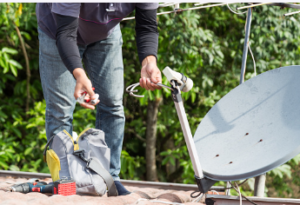Outdoor TV antennas provide access to various channels, such as local broadcasts. You can install one yourself if you possess the right tools and skill level – homeowners should not attempt it without prior permission from professionals.

Mount your antenna, connect it to a coaxial cable, and ground it – making sure that any applicable electric codes in your region are met as part of this process.
Mounting the Antenna
Outdoor TV antennas require careful planning and work to set them up and work. You can install it yourself or hire a handyperson; either option works.
Before installing an outdoor over the air antenna installation, it is a good idea to investigate broadcast channels available in your area and determine the likely signal reception type; this will enable you to choose an optimal-form antenna.
If you reside in an area with solid broadcast signals, outdoor over the air antenna installation should usually not present any difficulties as long as your antenna clears all obstacles that might obstruct it.
Obstructions such as trees, tall buildings and power lines may interfere with reception; in such instances, purchasing an extra antenna mounted higher up and away from them may be beneficial.
Once you have selected an antenna, its installation should begin soon. Again, a ladder or tripod is an excellent tool for this process.
Your mast should also be vertical for optimal reception performance, and you should use either a carpenter’s level tool or a smartphone app with a level feature to verify this. Doing this may help avoid reception problems due to improper mounting angles.
Once installed, connect your coaxial cable to your antenna – this connection will ensure you can receive all broadcasting channels.
As you connect the coaxial cable, be careful not to twist its ends, as this could cause interference and result in poor TV reception.
Connecting the Coaxial Cables
An outdoor TV antenna can provide your home with better TV reception; however, to maximise its effectiveness, you must connect the coaxial cable correctly so that your television receives all signals properly.
Various outdoor over the air antenna installation methods are available to connect an antenna and television/DVR, including running coaxial cable through walls or drop-down systems. Furthermore, distribution amplifiers offer more efficient solutions.
As part of your installation process, you may require several tools and techniques – including a screwdriver, drill bit, ladder and flashlight or headlamp for safety purposes – for this step.
Once you’ve collected everything necessary for setup, it’s time to connect your coaxial cables to your TV. Ensure the connection is weatherproof so moisture cannot seep into it and cause issues.
To ensure waterproof connections for cable connections, sealants such as silicone or grease must be used to provide waterproof sealant protection.
Coaxial cable length can also affect how strong a signal is transmitted, with longer distances often leading to more significant loss of movement; choose a reasonable and short length that suits your set-up best.
Another critical step is ensuring the antenna’s grounding system is in its correct place – otherwise, this could create a hazardous situation.
Assembling the Mounting Bracket
Installing an outdoor TV antenna requires more technical know-how than installing an indoor antenna; therefore, if you lack these skills or are concerned with safety concerns, it might be worth consulting a professional installer instead.
Once this task is complete, the next step will be connecting your coaxial cable to an antenna. Most antennas include connectors that will allow you to easily attach them to a TV or another device if your cables are shorter; otherwise, it would be wiser to invest in compression fittings to prevent twisting or breaking of longer cables.
Double-check that your coaxial cable can reach your antenna; according to Antennas Direct, up to one-third of your signal could be lost if it’s too long.
Grounding
Installing an outdoor TV antenna requires that the mast, cable run and coax cable that connects it to your home be grounded to protect from lightning strikes and electrical surges that may otherwise damage equipment. Doing this will prevent damage to the equipment caused by lightning strikes and surges.
Anchoring an antenna can be accomplished easily by attaching a ground wire at the top of its mast and running it back to your house’s ground wire. You may also use a ground strap or pipe clamp to connect this wire directly to the antenna mast.